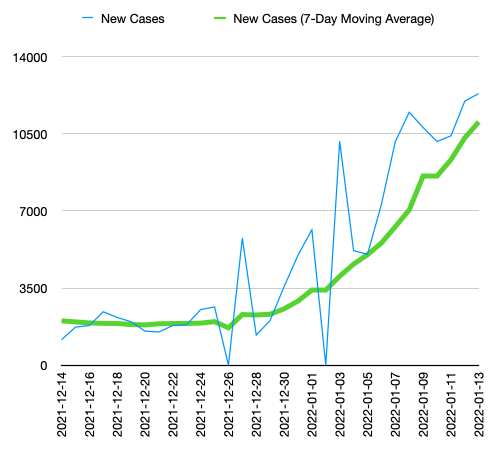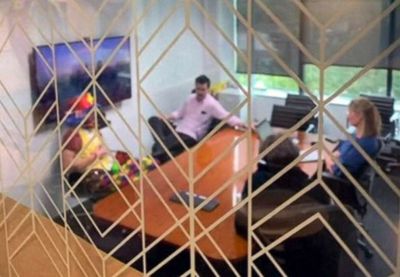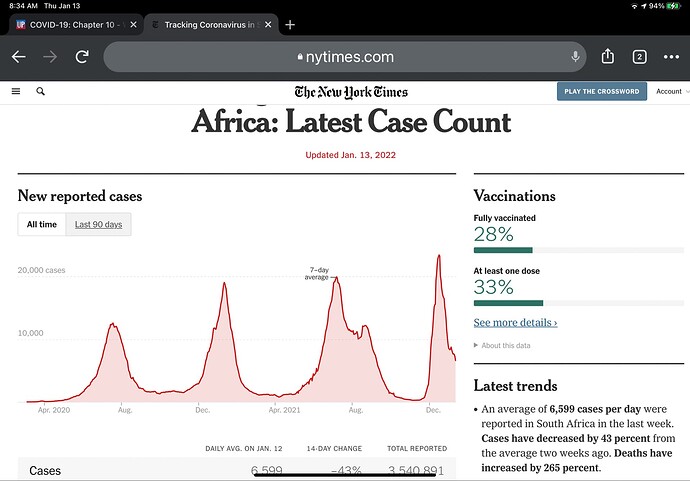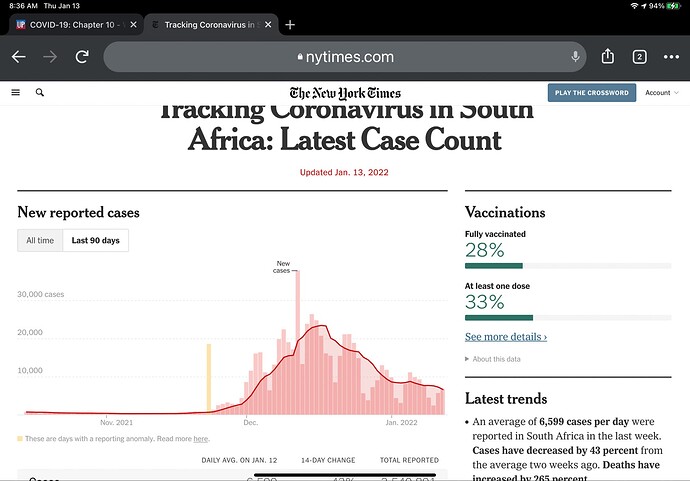In April of 2020, I was working on a public stock offering where I was writing a tax opinion, and I was on a phone call with the lawyers for the underwriters, whose job it is to basically grill me about everything that could go wrong with the opinion. My wife had her own immovable call, so I’m watching the kids while being interrogated (meaning they were watching Frozen), when my then 1.5-year old starts screaming uncontrollably. I pick him up, which lessens the screaming from lost soul being tormented in hell down to mere enraged toddler. He doesn’t want food or need a diaper change, he apparently just wants to scream. So I basically did a 20-minute Q&A session with a screaming toddler on my shoulder. It was not especially fun.
You’ve got to play this as a power move. “Agree to representations I’m asking for and I’ll get the baby to stop crying”.
Weird that different sources have such wildly different data, because the slope of decline for South Africa on the Nytimes tracker still looks pretty steep to me:
Source: Tracking Coronavirus in South Africa: Latest Case Count - The New York Times
Even zooming in it’s a pretty significant decline, there were a few days where it seemed to level out, but in the last few days, the negative slope of the 7dma has increased again:
Other guy: How did you deal with [intractable issue]?
Me: We eventually concluded that [drowned out by prolonged screaming], so it’s not an issue.
Other guy: Sorry, could you repeat that?
Me: I said that we determined [prolonged screaming], so we’re not worried.
Other guy: Umm, OK I’m sure that’s fine. Let’s move on.
Yeah, definitely in the have to wait to see more data category, not panicked yet. I’ve been hopeful of a spring time lull here, so any sign of oscillating waves grabs my attention. Worth keeping an eye on I think.
Is having a screaming irrational toddler in your legal negotiation better or worse than having a screaming irrational salesperson in your negotiation? I think I’d take the toddler.
I’d take either over a young lawyer eager to prove that they’re worth paying.
I saw a headline about Americans’ preferences regarding in-person versus remote schooling. I was initially pretty stunned by the headline numbers and now, after looking at the actual poll results, I’m just deeply confused. (Also, none of this matters because who cares what randoms think. But I still find it interesting.)
Here’s the headline:
Poll: Americans value “health and safety” over in-person learning
And this is the specific claim that was surprising to me:
More than half of Americans say that it’s more important to protect the health and safety of teachers and students by moving to remote learning to avoid COVID exposure than to keep schools open for in-person learning, according to a new Harris Poll provided exclusively to Axios.
I’m stunned at the idea that more than half the people in the US think that schools should move to remote learning right now. I’d actually be a little surprised if substantially more than half of the people here thought that, and this group is obviously more COVID-cautious than the general public.
So I dug around to try to find the actual poll questions, and the results are kind of all over the map.
Pg. 34: Which of the following do you believe is most important to continue into 2022?
- 62%: Protecting public health and reducing case numbers to as low as possible as to prevent hospitalization and deaths.
- 38%: Avoiding further disruptions to the U.S. economy, even if that means some level of risk within workplaces, schools, and public life.
So this puts a majority of respondents in the category of reducing the effect fo COVID. I’d argue with the “reducting case numbers to as low as possible” part of it, but I’m probably closer in sentiment to the first option than to the second.
But that isn’t very informative about people’s views on schools specifically. Pg. 45 asked “Which of the following do you think is more important when it comes to schools during the COVID-19 pandemic?”
- 56%: Protecting the health and safety of teachers and students by moving to remote learning to avoid exposure to COVID-19.
- 44%: Having schools in-person to avoid further interrupting students’ education, even if it means possible exposure to COVID-19.
This seems pretty consistent with the first question, in that a majority seems to prefer moving to remote school. And I assume this is the basis for the claim in the Axios headline.
But when the questions get more specific, things flip.
When asked “Which of the following comes closest to your point of view regarding how schools should respond to the current situation of the COVID-19 pandemic?” (p. 47), you get:
- 41%: Should be remote until the current surge of COVID-19 cases subsides.
- 30%: Only switch to remote learning if they do not have an adequate number of staff.
- 29%: Figure out how to hold in-person classes regardless of staff and student exposure risk.
I interpret these results as saying that a majority of people (30% plus 29%) do not want to pro-actively move students to remote learning.
When asked “If there is another surge of cases in the future [ed. note: if?], what do you think are the most important priorities for society in containing the spread?”, people were given the following options (P. 35-42):
- Enforcing mask mandates and expanding testing, but otherwise keeping everything open (top choice for 47%)
- Shutting down major events like sporting events and concerts (top choice for 23%)
- Moving schools to remote learning (top choice for 18%)
- Closing bars, restaurants, gyms, and other public venues (top choice for 12%)
The linked poll results have breakdowns by male/female, age group, political party, and vaccination status. But I don’t think they actually have a breakdown between parents with school-aged children and non-parents - that’s the split I was most interested in seeing, and the Axios story says that 62% parents with <18 year old kids chose health and safety over in-person learning. That’s higher than the overall number, which was suprising to me.
Again, none of this really matters, but it seems like when presented with the general question of “Do you want people to be safe?”, respondents answer “Yes, of course”. But when people are asked directly if they think schools should be remote right now, the majority says “No”. So I really don’t know what the average person is actually thinking.
7% of people released from isolation on day 6 under new rule will still be infectious, DHSC says
The Department of Health and Social Care has sent out its news release about the decision to cut the minimum isolation period to five days, and it says that it could result in 7% of people leaving isolation when they are still infectious.
That sounds worrying, but DHSC says that under the current rules, the figure is already 6%.
Although the way the government is presenting the new rule makes it sound as if the minimum isolation period is being cut by two days, in fact it is only a one day cut.
In December DHSC headlined its news announcement by saying the isolation period was being cut from 10 to seven days for people who do two negative lateral flow tests. But in fact the rules meant people would only have to spend six full days in isolation; if they did the second negative test early on day seven (a minute after midnight is theoretically allowed), they could spend the rest of day seven out of isolation.
Today DHSC has headlined its announcement as minimum isolation being cut to five full days. If the second negative lateral flow test takes place early on day six, the rest of day six is isolation-free. So it is only a one-day change.
DHSC says that after five full days of isolation, between 20% and 30% of people will still be infectious. But if they have to get two negative lateral flow tests before being allowed out of isolation on day six, UK Health Security Agency modelling suggests 7% of them will still be infectious.
Under the current rules, the same modelling says 6% of people are still infectious when released from isolation on day seven.
Because of the infection risk, people who leave isolation after two negative tests are still “strongly advised to wear face coverings and limit close contact with other people in crowded or poorly ventilated spaces, work from home if they can do so and minimise contact with anyone who is at higher risk of severe illness if infected with Covid”.
Sajid Javid, the health secretary, justified the move as “balanced and proportionate” taking into account the need for people to be in work.
Sounds like a strategy. Take a toy away just before the call. The other party will agree to anything just to get off the line.
i once worked at amazon, and they had just opened a dog friendly campus. so you could bring your german shepherd in. i always wondered what would happen if you brought a scary animal to a performance review or a salary negotiation. or an exit interview!
but a dog and a screaming toddler would be even more alpha
It seems like we’re several weeks behind in some parts of the West. In Maricopa County, we didn’t really start breaking out until the last week of December and no peak in sight:

Reminds of one of my favourite stories of the last few years - the Kiwi who took a clown to his redundancy meeting for “support”.

Too funny 

This is great news and yet more evidence that vaccines such as AstraZeneca have not had their efficacy reduced to “basically nothing.”
C’mon, don’t stir up drama.
This is why polling on issues is useless.
Mask testing from Amazon.
Related: just today I found some 3M Auras in stock at a local Home Depot for like $2/mask. If y’all are in the market it might be worth checking: https://www.homedepot.com/p/3M-Aura-Particulate-Respirator-N95-Foldable-10-Pack-9205P-10-DC/316909322
That preprint about omicron requiring no intubations looks like bullshit now. How someone had no vent requirements but did have deaths is beyond me. More importantly:
https://twitter.com/hkalodimos/status/1481635117357428736?s=21
Makes sense given it was a study of Kaiser patients who are typically have higher social determinants of health

